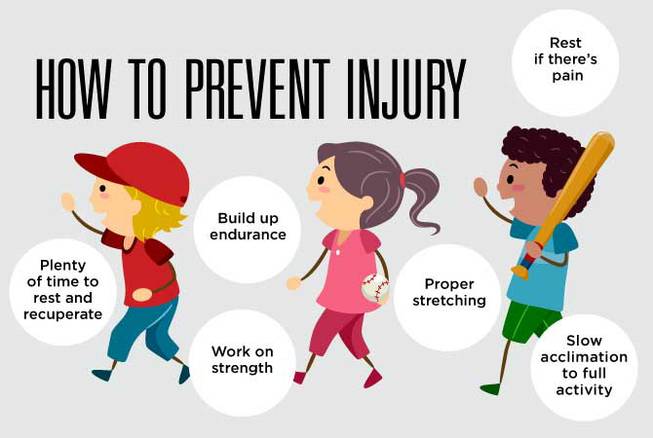
Sunday, May 17, 2015 | 2 a.m.
Children tend to be more active than adults, especially when it comes to team sports. And active competition can mean higher risk. Because children still are growing, they’re susceptible to many overuse injuries.
“The most important thing to remember is that kids are not little adults,” said Dr. Jason Nielson, Adolescent Sports Medicine and Pediatric Orthopedic Surgeon for Children’s Bone and Spine Surgery and Sunrise Children’s Hospital. “They don’t get the same injuries, and we can’t train them in the same ways.”
Overuse injuries vs. trauma injuries
Full-contact sports, such as football, can cause traumatic injuries, but the most common sports injuries among children are due to overuse.
“Overuse injuries are very common in children because their bodies are still developing, they’re growing rapidly and they’re not yet as coordinated as adults are,” Nielson said. Paired with vigorous exercise routines and year-round sports schedules, it leaves children vulnerable to serious injury.
“We see a lot of knee injuries, especially ACL tears, and it’s not from any kind of traumatic accident,” Nielson said. “Usually, it’s coming from pivots, lost balance or just a bad misstep. They could have been running in a bubble and done the same thing.”
Doctors are seeing more injuries in girls
“This is the day of the young female athlete, and they need to be especially careful because they’re getting injured much more often and more seriously than their male counterparts,” Dr. Jason Nielson said. Girls are prone to knee injuries, particularly ACL tears.
Among the possible reasons: hormonal fluctuations caused by menstruation, wider hips, a different width of the notch in the knee, a different width of the ACL, and balance issues.
“We don’t exactly know the main reason young women are presenting these injuries in such high numbers, but it’s a very active area of research and study right now,” Nielson said.
The vulnerability of growth plates
“The large majority of injuries I see are related to open growth plates in the joint,” Nielson said.
In joints, a band of cartilage sits at the end of each long bone. The cartilage allows the long bones to grow by giving them a flexible anchor in the joint. All children start with open growth plates, and as they mature, the cartilage begins to solidify into bone. This happens to most major growth plates — knees, hips, wrists and others — when a girl is 14 years old and a boy is 15 years old, on average. The last growth plate to fill in is at the clavicle; that typically takes place at about 21 years old.
“Open growth plates often cause injury in children because their joints aren’t as strong as adult joints and are more easily fractured. Kids are also far more prone to broken bones pre-puberty,” Nielson said.
Treatment
Certain injuries may be treated differently depending on how far along a child or teen is in his orthopedic development — in other words, how developed their growth plates are.
“If a 15-year-old boy comes in with a fractured wrist where the growth plate is greatly displaced, we’ll have to reset it perfectly, otherwise he could potentially have a deformity for the rest of his life, because the cartilage is about to become bone when the injury occurred. A 5-year-old with a similar injury may not need special treatment at all, because the growth plate is still so open and ready for all new bone to grow. It could heal perfectly on its own with time,” Nielson said.
Prevention tips
1. Plenty of time to rest and recuperate, both immediately after exercise and over time.
2. Slow acclimation back to full activity (i.e. conditioning during the summer before jumping back into a sport). “After long periods of inactivity, kids really need to condition their bodies to exercise because their joints and growth plates aren’t prepared,” Nielson said.
3. Proper stretching. “As kids grow, they intrinsically tighten up, and that tightening can pull unevenly on joints and growth plates,” Nielson said.
4. Endurance. “Working on endurance is important so that the child doesn’t get fatigued easily,” Nielson said. “Lots of injuries happen at the end of the game when the child is fatigued.”
5. Strengthening. “We often think that kids shouldn’t work on strengthening, but that’s absolutely not true,” Nielson said. “That’s not to say they should be lifting weights or trying to bulk up, but they should work on strengthening their muscles and increasing endurance.”
6. Rest if there’s pain. “Pain says when it’s time to stop,” Nielson said. “Children should never be pushed past that point.”

Join the Discussion:
Check this out for a full explanation of our conversion to the LiveFyre commenting system and instructions on how to sign up for an account.
Full comments policy